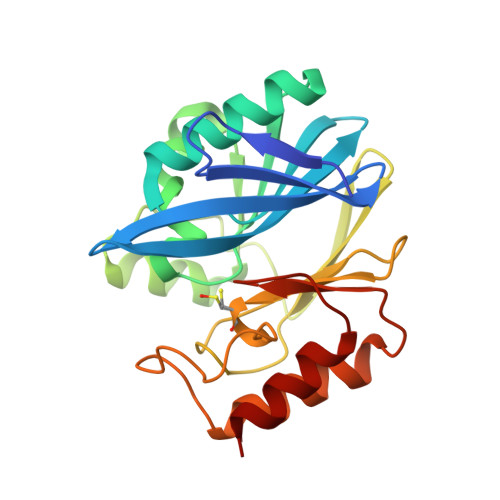Structure activity relationship studies on rhodanines and derived enethiol inhibitors of metallo-beta-lactamases.
Zhang, D., Markoulides, M.S., Stepanovs, D., Rydzik, A.M., El-Hussein, A., Bon, C., Kamps, J.J.A.G., Umland, K.D., Collins, P.M., Cahill, S.T., Wang, D.Y., von Delft, F., Brem, J., McDonough, M.A., Schofield, C.J.(2018) Bioorg Med Chem 26: 2928-2936
- PubMed: 29655609
- DOI: https://doi.org/10.1016/j.bmc.2018.02.043
- Primary Citation of Related Structures:
5JMX, 6EUM, 6EW3, 6EWE, 6F2N - PubMed Abstract:
Metallo-¦Â-lactamases (MBLs) enable bacterial resistance to almost all classes of ¦Â-lactam antibiotics. We report studies on enethiol containing MBL inhibitors, which were prepared by rhodanine hydrolysis. The enethiols inhibit MBLs from different subclasses. Crystallographic analyses reveal that the enethiol sulphur displaces the di-Zn(II) ion bridging 'hydrolytic' water. In some, but not all, cases biophysical analyses provide evidence that rhodanine/enethiol inhibition involves formation of a ternary MBL enethiol rhodanine complex. The results demonstrate how low molecular weight active site Zn(II) chelating compounds can inhibit a range of clinically relevant MBLs and provide additional evidence for the potential of rhodanines to be hydrolysed to potent inhibitors of MBL protein fold and, maybe, other metallo-enzymes, perhaps contributing to the complex biological effects of rhodanines. The results imply that any medicinal chemistry studies employing rhodanines (and related scaffolds) as inhibitors should as a matter of course include testing of their hydrolysis products.
Organizational Affiliation:
Department of Chemistry, University of Oxford, Chemistry Research Laboratory, 12 Mansfield Road, Oxford OX1 3TA, United Kingdom.



















